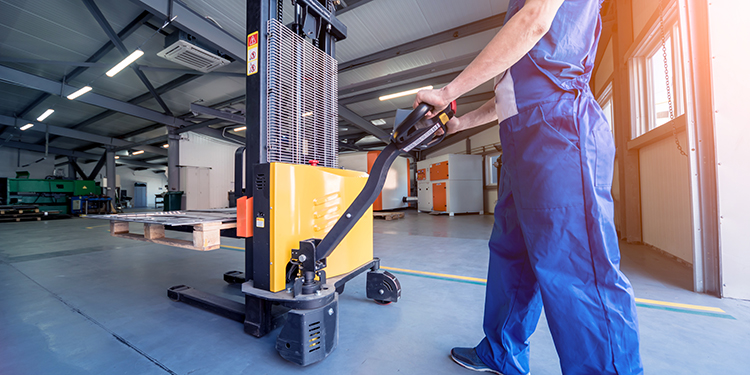Guidelines For Safe Equipment Use Minimize Risk Of Worker Injuries

For operations looking to move away from exclusively using human power to handle individual items and containers in warehousing and fulfillment operations, there are a variety of recommendations for the selection of — and guidelines for the safe use of — ergonomic material handling equipment. These include introducing the use of tools, adding non-powered equipment, or adding powered systems to improve ergonomics and minimize the risk of an injury caused by repetitive stress or excessive exertion. Examples of safe equipment include:
- Tools, such as a siphon and pump, can be used to empty the contents of a drum instead of workers physically lifting and tilting it. Further, using a simple hook to pull items stored at the back of a rack to the front makes it easier to pick products to fill orders.
- Non-Powered Equipment, such as a wheeled drum dolly, wheeled cart, hand truck, platform truck, pallet jack, or portable scissor lift whose platform rises and descends with manual pumping of a handle or pedal, makes it easier to move several items at one time without being carried. Likewise, chutes, slides, spirals, and skate wheel conveyors use gravity and inertia to impel a product or container from one point to another with minimal manual intervention.
- Powered Systems, like powered hand trucks or stackers, move and transport loads automatically with very little direction from an operator. Other powered ergonomic lift and transport assist systems include powered pallet trucks, vacuum lifters, workstation cranes, scissor lifts, industrial tilters, and powered lift tables all eliminate the need for a worker to physically handle the load.
Guidelines Help With Safe Equipment Selection
To help employers and operations managers select safe equipment for their unique application — as well as to create a safe work environment and design appropriate and safe handling practices when using the equipment — a list of guidelines for equipment use is offered. The list is part of a free, downloadable workplace safety handbook produced by the Ergonomic Assist Systems & Equipment (EASE) Council of MHI, the National Institute for Occupational Safety and Health (NIOSH), and the California Division of Occupational Safety and Health (Cal/OSHA): “Ergonomic Guidelines for Manual Material Handling.” The guidelines help managers modify the work and the loads handled while simultaneously coaching employees on how to significantly lessen their risk of ergonomic injury.
How to Pick Safe Equipment
Safe equipment selection recommendations include:
- Prior to purchasing tools, non-powered, or powered handling equipment, understand the dimensions, weight, and volume of the load. Use this information to buy equipment with the appropriate handling capacity. The lighter weight the equipment, the easier it is to move (and the more likely it is to be used).
- Select the equipment that is optimal for handling the material(s), the layout and design of the workplace, and the required tasks.
- When excessive manual pulling or pushing forces exist, consider investing in powered equipment (instead of non-powered) to reduce or eliminate the physical strain on employees.
- If available, select equipment with handles located in the workers’ power zone (typically waist-high).
- For transport of items, choose wheeled equipment that minimizes start forces (inertia) and reduces rolling resistance. The amount of force required to move loads with wheeled equipment depends on multiple factors, such as:
- Load weight and shape
- Floor surface type and condition (smoothness, density, and other factors)
- Route followed (slopes, obstacles, doorways, and more)
- Wheel material type
- Wheel size (wheels measuring 6 inches or more in diameter typically move more easily over holes, bumps, and other floor irregularities)
- Wheel maintenance requirements, including cleaning, lubricating, and/or replacing all wheels regularly for maximum functionality
- Prior to use, properly ground all electrically powered equipment.
- Verify that all equipment safety sensors, alarms, and warning devices are visible, audible, and working properly.
- Inspect and maintain all equipment according to manufacturers’ recommendations.
- Follow all manufacturers’ recommendations for proper use of the equipment.
Guidelines to Improve the Work Environment
In addition to the guidelines for safe equipment use, there are several best practices for improving the overall work environment, such as:
- Clear aisles, doorways, and other obstacles to create a safe passage for guiding and maneuvering load handling equipment.
- Deploy safety barriers that prevent employees from coming too close or being beneath supported or moving loads.
- Utilize equipment outfitted with four swivel casters or wheels when navigating tight spaces, as these allow for easier turning and control.
Recommendations to Safeguard Employees Using Load Handling Equipment
To further safeguard the wellbeing of employees interfacing with the load handling tools, powered, or non-powered equipment, recommendations include:
- Train employees on how to use the equipment properly and on safe, appropriate work practices.
- Demonstrate how to push and pull equipment with the entire body instead of just arms and shoulders to reduce the risk of injury.
- Teach employees to use both hands when pushing or pulling load handling equipment.
- When transporting heavy loads over long distances, either reduce the size of the load or use powered equipment instead.
- Inspect pallets prior to loading or moving them to ensure they are intact and damage-free. Pallets with missing or broken boards can cause equipment to jam or fail.
Need more ideas for ways to minimize the risk of employee injuries and improve workplace safety by incorporating ergonomic material handling solutions? The members of the Ergonomic Assist Systems & Equipment (EASE) Council of MHI are always available to consult, answer questions, and make recommendations about safe equipment use. Learn more about EASE.



